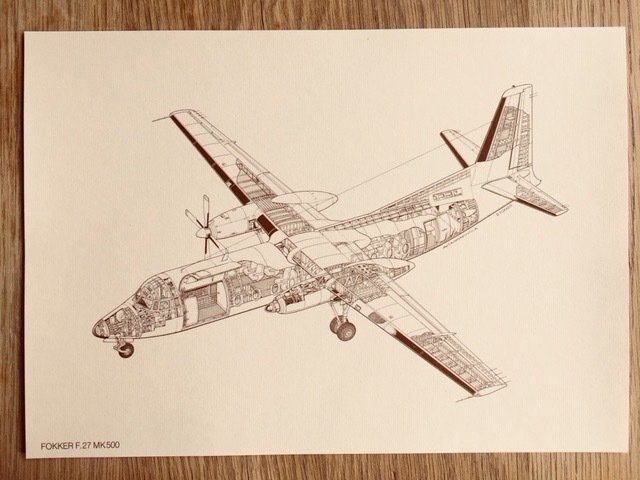N. 14967295

Old Fokker fighter aircraft - 24 unique openwork drawings (for framing!)
N. 14967295

Old Fokker fighter aircraft - 24 unique openwork drawings (for framing!)
Collection of 24 beautiful unique cut-away drawings of old Fokker aircraft (24.5 cm x 34.5 cm) - in new condition. The drawings were made at the time by R. ter Cock:
1) C.IV 1923/1924 was a type with great flexibility in terms of outfitting with a choice of three water cooled engines (420pk Packard "Liberty", 350hp, R&R Eagle VIII, 450pk Napier "Lion") and various wing designs. The C.IV-A was used by the DUTCH COLONIAL FORCES (KNIL) under type designation D.C.I. The B and C models were deployed by the air forces of Russia, Spain, Italy, Argentina and America.
2) A plane that boosted European air traffic, the Fokker F.VII from 1924. The prototype flew from Schiphol to Batavia, establishing a connection by air to Indonesia. Engines used were the R&R Eagle IX, the Napier Lion or the 480 HP Gnome Rhone Jupiter.
3) D.XVII from 1931 was a relatively inexpensive but reliable plane. It could be equipped with various engines like e.g. the Curtiss "Conquer" or the Lorraine "Petrel".
4) 1923 was the birth year of the D.XIII, a one and a half wing plane. Equipped with a 450pk Hispano Suiza or Napier "Lion", this plane was extremely fast. Which resulted in 4 new speed records. This model was also a popular training plane.
5) De C.V. series 1924/1934 was developed from the C.IV. The C.V series also had a large number of different versions. The C.V-A was a tactical reconnaissance plane, the C.V-B a reconnaissance plane, and the C.V-C a light bomber. The C.V-E was built with a Bristol Pegasus engine.
6) The Fokker F.II was the first airliner in the world designed as a comfortable passenger aircraft. This plane was used by many airlines on regular scheduled flights. Comfort came in first place, due to the closed passenger cabin, which was unique in 1919. The hull was welded from steel tubing, lined with fabric, and the cantilevered wing was wood. It could be fitted with a 185pk BMW or a 240pk Armstrong Siddeley Puma engine.
7) The D.VII from 1918 was a fighter aircraft with great success. Over 1350 units of this model were built, and it played a large role at the end of the 1st World War. The used engines ranged from 160hp Mercedes to the 250 hp BMW.
8) In 1910 Anthony Fokker built his dream: an aeroplane! Built from wood, canvas, steel tube and steel wire. The 50 HP Argus was used for an engine. The plane soon got the name SPIDER because of the many tensioning wires. The plane was not equipped with role and rudder. The second version of the Spider did have had both role and rudder. And the third version again did not have ailerons, because this model was very stable. A replica of the original Spider can be admired in the Aviodrome in Lelystad.
9) S.14 Mach Trainer from 1951 was the first jet engine plane specifically developed as a training device. The wide cockpit was equipped with 2 side by side-mounted ejection seats. Initially the prototype had the Rolls-Royce Derwent 8 turbine (known for the Gloster Meteor) and was later mounted with the heavier R-R Nene with 5100lbs thrust.
10) The F.VIIa was a more aerodynamic version of its predecessor the F.VII. The F.VIIa from 1925 had beautiful tapered wings, with built-in ailerons. A special version was in service as a mail plane for the Swiss postal service.
11) F.IV was an extended version of the F.III, specially for the American market. This custom made plane could carry a total of 11 passengers, in 2 separate sections. It had the 400hp 12 cylinder Packard Liberty engine. A long distance record was set in 1922: New York - San Diego, a distance of 4586 km.
12) A plane that boosted European air traffic, the Fokker F.VII from 1924. The prototype flew from Schiphol to Batavia, establishing a connection by air to Indonesia. Engines used were the R&R Eagle IX, the Napier Lion or the 480 HP Gnome Rhone Jupiter.
13) The tri-engine F.XX which was finished in 1933, differed heavily from previously developed planes, despite the usual construction. The hull had a streamline-shaped elliptical cross section and the main undercarriage was retractable. Only 1 unit of this type was produced, and it got the name "Silver Gull". Originally the plane was equipped with 3x 640pk Wright Cyclone R-1820F engines, but these were later replaced by 690pk strong F2 engines.
14) Historically, the Fokker T.VIII-W from 1938 had a very interesting design, as a successor of the highly outdated T.IV torpedo plane. 3 versions were built i.e. the T.VIII-Wg with mixed construction, the T.VIII-Wm entirely made of metal, and the T.VIII-Tv -a larger version in wood and metal. The Wg and the Wm had the 420hp Wright Whirlwind R 975-E-3 radial engine, and the Wc had the 890pk Bristol Mercury XI engine. Interesting detail: this plane was used both by the English and the German Air Force during the beginning of the 2nd World War.
15) With a seat that could be converted to a bed, the F.XVIII was deployed on the Indies route in 1932, and could carry 4 passengers in great comfort. In the normal version it could carry 13 passengers. This plane became famous under the name ‘Pelican’ for various record flights, including the famous Christmas flight to the East in 1933. This model was then equipped with Wasp T1D1 engines with adjustable screw.
16) The successor to the F.II, the F.III, from 1921 was also used for scheduled flights by various airlines all over the world, and even in New Guinea.
17) C.X was developed in 1934 as a hunter-reconnaissance plane and light bomber, as a successor of the C.V-D and E models. Originally equipped with an open cockpit, and in later versions with a foldable cockpit roof. It had 650 HP R&R Kestrel engines, and later the 925 HP Bristol "Pegasus".
18) Fokker entered the jet age with the F.28 Fokker in 1967. This jet plane, was very suitable for smaller airports,, due to the typical air brakes in the tail, which made a slow and stable approach possible. Very economical on short distances, which made the F.28 attractive for flying within Europe as a Cityhopper. It was also popular on the other side of the world. With its quite large cargo door and wings, the F.28 was also developed, for carrying quite large loads of freight in addition to 28 passengers.
19 and 20) The F.27 FRIENDSHIP was developed as a modern replacement for the famous DC-3 in 1953, commissioned by the Dutch Institute for Aircraft development. In 1955 the first test flight was carried out, and Air Lingus had was the first to take the plane into active service. The Fokker F-27 had great success: over 580 units were built, in all sorts of variations. It could carry 40-56 passengers. The F-27 was equipped with Rolls-Royce Dart engines which could supply 1715 or 2050 HP.
21) The Fokker F.XXII had four engines, and due to its wide hull it could carry 22 passengers. The extremely strong 525hp Pratt & Whitney Wasp engines made this plane a giant in the air. 2 planes ended up in the RAF and the Royal Navy as a training aircraft for navigators and observers, and as a staff-transporter.
22) In 1936 the last Fokker fighter aircraft was developed: the D.XXI. The performance of this model were extremely good and thus very popular with various air forces. This plane was used in May 1940 against the German Luftwaffe. The Bristol "Mercury" 645hp engine gave this plane a boost.
23) After the 2nd World War Fokker started to develop training aircraft, besides the F.25. This resulted in the production of the S.11 "Instructor" and the S.12 with a nose wheel. The S.11 still had a traditional fuselage made from steel tube covered with fabric, but with a light metal wing. It was equipped with a 190hp Lycoming O-435-A "flat six" engine.
24) A twin-engined advanced combat aircraft, with 2 tail carriers, caused a sensation in 1936 at the Paris air show. The G.1 was a revolutionary concept due to its construction and its strong frontal armament, which made it an ideal attack aircraft. The frontal armament could be fitted with 2x 23 mm Madsen cannons and 2x machine guns or four Oerlikon cannons or 8 synchronized machine guns. This is the reason the G.1 was nicknamed "the mower"! The X-2 (later registered as mil. no. 341) flew as a prototype in 1937, with two Hispano Suiza 80-02 radial piston engines that turned against each other. The Lockheed Lightning followed this same principle. The Hispano engines were not trouble-free, and were replaced by Pratt & Whitney Twin Wasps (G.1 B). A larger version for 3 passengers was developed under the name G.1.A and equipped with 2x Bristol Mercury VIII radial piston engines of 830 HP. This model was also featured a rotating machine gun in the conical tail, besides the front armament .
Now that Fokker was sold in 2015 to an English company (GKN Aerospace) and KLM retired its last Fokker plane last month, this collection is even more interesting, something for the real enthusiast ...!
Will be shipped by registered mail.
Questo oggetto era presente in
Come fare acquisti su Catawiki
1. Scopri oggetti speciali
2. Fai l’offerta più alta
3. Paga in tutta sicurezza
